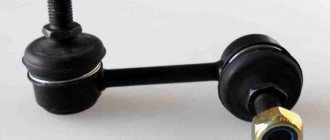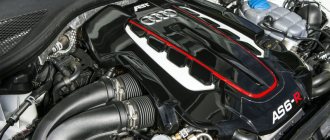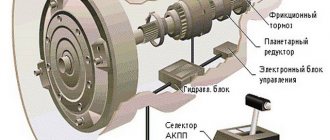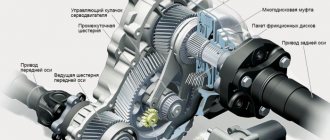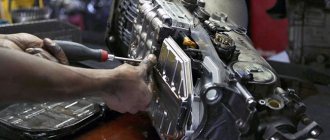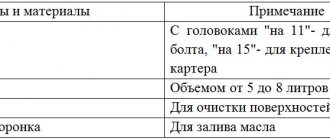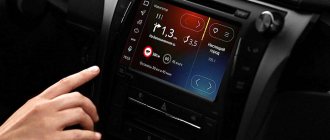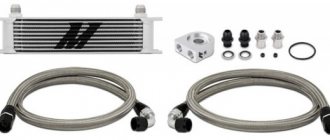A car's transmission is a whole complex of mechanisms that ensures the functioning of all its driving mechanisms and transfers the energy of the internal combustion engine to them. Literally, the word “transmission” from English into Russian can be translated as follows: “transfer”, “transfer”, “translation”. In fact, even a simple chain drive on a bicycle is already a transmission. But when applied to bicycles, the word “transmission” did not catch on. It is customary to say “transfer”. But in the field of mechanical engineering and transport technologies, the concept of “transmission” is applied both to the mechanisms connecting the internal combustion engine with moving elements, and to the systems that ensure the functioning of such mechanisms. Although, if we are already talking about a bicycle, then using its example it is easiest to clearly explain the essence of the transmission as such. To move quickly on a bicycle, you need a high rotation speed of the rear drive wheel. A chain drive ideally allows you to solve this problem without changing the diameter of the wheel. True, if we consider the structure of cars, then the engine already appears, and the design becomes more complicated, as does the range of its “responsibilities”. For example, when driving an internal combustion engine, you constantly need to expend energy to overcome all kinds of resistance, including overcoming the inertia of the car itself. Fuel consumption, safety and comfort of the driver and passengers of the vehicle, and the efficiency of performing certain tasks depend on the quality of transmission mechanisms (MT). For example, MT forklifts provide the operator with comfortable interaction with the forklift, freely drive up to the racks and carefully unload it. The smoothness of the transfer of actions from the internal combustion engine to the mechanisms of the reaping part depends on the MT of the combine. The MT of a mining dump truck determines whether it can provide an effective start after the body is fully loaded or whether it can move uphill at high speed.
Purpose of a car transmission
The purpose of this mechanism is simple - to transmit the torque coming from the motor to the drive wheels and change the rotation speed of the secondary shafts. When the engine starts, the flywheel rotates in accordance with the crankshaft speed. If it had a rigid grip on the drive wheels, then it would be impossible for the car to start moving smoothly, and every stop of the vehicle would require the driver to turn off the engine.
Everyone knows that battery power is used to start the engine. Without a transmission, the car would immediately start moving using this energy, which would drain the power supply very quickly.
The transmission is designed so that the driver has the opportunity to disconnect the driving wheels of the car from the engine in order to:
- Start the engine without overcharging the battery;
- Accelerate the vehicle without increasing engine speed to a critical value;
- Use coasting motion, for example, in case of towing;
- Choose a mode that would not harm the engine and ensure safe traffic movement;
- Stop the car without having to turn off the engine (for example, at a traffic light or to let pedestrians cross a zebra crossing).
Also, the car's transmission allows you to change the direction of torque. This is required for reversing.
And another feature of the transmission is to convert the engine crankshaft speed into an acceptable wheel speed. If they were spinning at speeds in the range of 7 thousand, then either their diameter would have to be very small, or all the cars would be sports cars, and they could not be safely driven in crowded cities.
The transmission evenly distributes the released engine power so that the moment of transformation makes possible a soft and smooth start and uphill movement, but at the same time allows the use of internal combustion engine power to accelerate the vehicle.
Device
During the combustion of fuel in the power unit, a large amount of free energy is generated, which must be transferred to the driving wheels of the vehicle. The simplest transmission consists of four parts: clutch, gearbox, drive axle and differential. The first element is located between the motor and gearbox. The clutch ensures smooth operation when starting or changing gears. There are two versions of the mechanism - dry and wet. In the first case, the discs operate using friction, in the second they operate in a liquid. A number of cars have a hydraulic or electromagnetic clutch, but such variations are not very common. The mechanism itself is based on two disks, one of which is the master and the second is the slave. In the normal state they are compressed, but when the corresponding pedal is pressed they are released.
The gearbox controls wheel speed, reverse driving, and disconnects the engine and transmission for long periods of time. The gearbox can be stepped or continuously variable. The first includes “mechanics” and a robot, the second – a variator. The most reliable gearbox is considered to be a manual one, but operating it requires appropriate skills. So far, manual transmission is the most common, but it is gradually being replaced by automatic transmission.
A bridge is a support on which the frame of a vehicle is attached. He can be a leader or a follower. The first receives torque from the box and sets the wheels in motion. The driven axle acts as a simple support. It can also be front and rear, and trucks also have a middle one.
A differential is a structure that divides the mechanical energy of the power unit into two streams and directs it to the wheels. This element prevents tires from slipping on uneven road surfaces. The differential is indispensable when traveling in icy conditions, in winter or on poor roads.
Transmission types
Although manufacturers have developed and continue to create different versions of transmissions, they can all be divided into four types. Below is a brief description of the operating features of each of them.
Manual Transmission
This is the very first and most popular type of transmission. Even many modern motorists choose this particular gearbox. The reason for this is a simpler structure, the ability to use the chassis of the car instead of a starter to start the engine if the battery is low (read about how to do this correctly here ).
The peculiarity of this box is that the driver himself determines when and what speed to turn on. Of course, this requires a good understanding of what speed to upshift or downshift at.
Due to its reliability and relative ease of maintenance and repair, this type of transmission remains a leader in the gearbox rating. For the production of mechanics, the manufacturer does not spend as much money and resources as for the production of automatic machines or robots.
Gear shifting occurs as follows. The gearbox device includes a clutch disc, which, when you press the appropriate pedal, disconnects the engine flywheel from the drive mechanism of the box. While the clutch is disengaged, the driver shifts the unit to another gear. This way the car accelerates (or slows down), and the engine does not suffer.
The design of manual transmissions includes a set of gears and shafts that are interconnected in such a way that the driver can quickly change the desired gear. To reduce noise, the mechanism uses gears with oblique teeth. And for stability and speed of engagement of elements, modern manual transmissions use synchronizers. They synchronize the rotation speed of the two shafts.
Read about the mechanics in a separate article.
Robotic transmission
In terms of design and principle of operation, robots are very similar to their mechanical counterparts. Only in them the selection and shifting of gears is carried out by the car's electronics. Most robotic transmissions have a manual mode option, where the driver uses the shift lever located on the mode selector. Some car models have steering wheel paddle shifters instead of this lever, with which the driver upshifts or downshifts.
To increase stability and reliability of operation, modern robots are equipped with a dual clutch system. This modification is called selective. Its peculiarity is that one clutch disc ensures normal operation of the box, and the second, before shifting the next gear, prepares the mechanisms for activating speed.
Read about other features of the robotic gear shift system here.
Automatic transmission
Such a box is in second place in the ranking of similar mechanisms after mechanics. Such a transmission has the most complex structure. It has many additional elements, including sensors. However, unlike its robotic and mechanical counterparts, the automatic does not have a clutch disc. Instead, a torque converter is used.
A torque converter is a mechanism that operates based on the movement of oil. The working fluid is supplied by a pump to the clutch impeller, which drives the transmission drive shaft. A distinctive feature of this box is the absence of a rigid coupling between the transmission mechanism and the engine flywheel.
An automatic transmission works on a similar principle to a robot. The electronics itself determines the moment of transition to the desired mode. In addition, many automatic machines are equipped with a semi-automatic mode, when the driver, using the shift lever, commands the system to switch to the desired gear.
